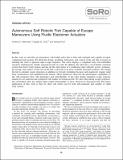Autonomous Soft Robotic Fish Capable of Escape Maneuvers Using Fluidic Elastomer Actuators
Author(s)
Onal, Cagdas D.; Marchese, Andrew Dominic; Rus, Daniela L
DownloadMarchese-2014-Autonomous Soft Robotic Fish Cap.pdf (750.4Kb)
PUBLISHER_POLICY
Publisher Policy
Article is made available in accordance with the publisher's policy and may be subject to US copyright law. Please refer to the publisher's site for terms of use.
Terms of use
Metadata
Show full item recordAbstract
In this work we describe an autonomous soft-bodied robot that is both self-contained and capable of rapid, continuum-body motion. We detail the design, modeling, fabrication, and control of the soft fish, focusing on enabling the robot to perform rapid escape responses. The robot employs a compliant body with embedded actuators emulating the slender anatomical form of a fish. In addition, the robot has a novel fluidic actuation system that drives body motion and has all the subsystems of a traditional robot onboard: power, actuation, processing, and control. At the core of the fish's soft body is an array of fluidic elastomer actuators. We design the fish to emulate escape responses in addition to forward swimming because such maneuvers require rapid body accelerations and continuum-body motion. These maneuvers showcase the performance capabilities of this self-contained robot. The kinematics and controllability of the robot during simulated escape response maneuvers are analyzed and compared with studies on biological fish. We show that during escape responses, the soft-bodied robot has similar input–output relationships to those observed in biological fish. The major implication of this work is that we show soft robots can be both self-contained and capable of rapid body motion.
Date issued
2014-02Department
Massachusetts Institute of Technology. Department of Electrical Engineering and Computer ScienceJournal
Soft Robotics
Publisher
Mary Ann Liebert, Inc.
Citation
Marchese, Andrew D., Cagdas D. Onal, and Daniela Rus. “Autonomous Soft Robotic Fish Capable of Escape Maneuvers Using Fluidic Elastomer Actuators.” Soft Robotics 1, no. 1 (March 2014): 75–87. © 2014 Mary Ann Liebert, Inc.
Version: Final published version
ISSN
2169-5172
2169-5180
